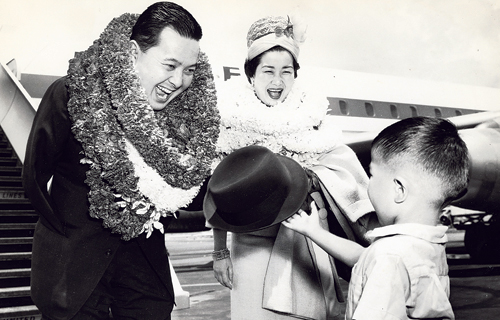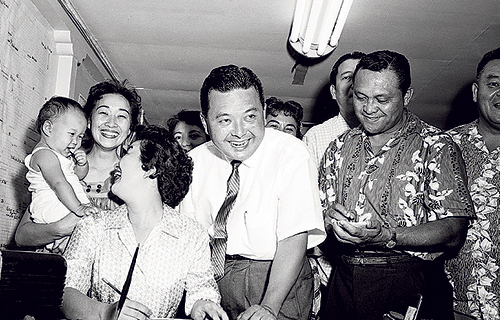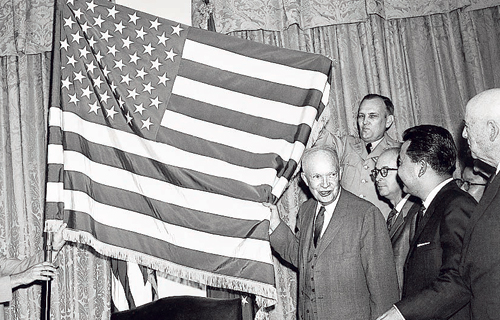Pivotal moment

Oswald Kawahara, 5, greets Inouye and his wife, Margaret, with the U.S. representative's hat, which Oswald had retrieved, upon the Inouyes' arrival in Honolulu.

Supporters at Inouye's campaign headquarters are jubilant as his Republican opponent for Hawaii's seat in the U.S. House of Representatives concedes defeat.

Inouye and other officials looked on as President Dwight Eisenhower helped unfurl the new 50-star flag in Washington after signing a proclamation making Hawaii the nation's 50th state.



« Previous article: Go for broke (3 of 9)
After the war, Hawaii was on the brink of social change. Japanese-Americans were a third of the state’s population, and the nisei veterans soon realized their political potential. Republicans had dominated state politics since the overthrow of the Kingdom of Hawaii in 1893, but had grown stodgy as the voice of the Big Five corporations that still mostly ran the islands. The Democrats were largely controlled by the International Longshore and Warehouse Union.
Inouye enrolled in prelaw classes at UH under the GI Bill with an eye toward politics, not the courtroom. He met Margaret Shinobu Awamura, a UH speech instructor who had earned a master’s degree in education at Columbia University in New York, and on their second date asked her to marry him.
Although their courtship was typical of young Hawaii couples — he proposed while parked off the beach at Ala Moana — out of Japanese tradition and respect for their parents, they allowed family friends to be matchmakers and arrange their marriage.
|
"How many one-arm Japanese do you think we have in the Congress of the United States?" |
His wife was the breadwinner while Inouye finished classes at UH. He completed law school at George Washington University a few blocks from the White House, which Inouye chose so he could soak up the political atmosphere of the nation’s capital.
Don't miss out on what's happening!
Stay in touch with breaking news, as it happens, conveniently in your email inbox. It's FREE!
When the couple came back home, and the day after Inouye passed the state bar exam, he was appointed deputy city prosecutor. Inouye had already been volunteering for Democrats in Washington and Hawaii and had become a disciple of John Burns, a former Honolulu police captain who had stood up for the rights of Japanese-Americans during the war.
Burns, who would later become the state’s most revered governor, was a talisman for many young Democrats. He was an advocate for workers and civil rights and saw the political value of linking the union movement with the struggles of emerging Japanese-Americans. It was Burns who urged Inouye to run for the Territorial House in 1954.
Organized labor was — and still is — the motor within the Democratic Party of Hawaii. Japanese-Americans brought race and class to the surface, along with the passion of the nisei who had fought for their country and were not about to meekly return to the status quo.
Several nisei veterans banded together to form Central Pacific Bank to serve a Japanese immigrant community that had been isolated and stigmatized during the war. Inouye bought into the bank with a minimum share of $300 and became secretary.
During the 1954 campaign, some Republicans portrayed Democrats as tools of the ILWU and even communist sympathizers. Inouye became so furious at one event in Aina Haina that he used his disability as a political weapon. "I held up my empty right sleeve and shook it," he wrote. "I gave this arm to fight fascists," he told the audience. "If my country wants the other one to fight communism, it can have it."
The Democratic takeover of the Legislature in 1954 was a pivotal moment in Hawaii’s history, leading to more than a half-century of nearly unbroken party rule. Along with Inouye, the class of new lawmakers included future U.S. Sen. Spark Matsunaga and future Gov. George Ariyoshi.
With Democrats unaccustomed to power, the first few years after the takeover were often messy, with internal strife and grandiose visions of change. Inouye, who lost a bid for House speaker but was selected majority leader, recalled writing U.S. House Speaker Sam Rayburn, a Texas Democrat, for advice.
Big ideas — equal opportunity, worker rights, access to health care, better public schools — also took root during the chaos.
Inouye, who was elected to the Territorial Senate in 1958, gained political experience and name recognition that would position him for federal election after Hawaii became a state in 1959.
Much of Hawaii’s ruling class had initially been against statehood, since the wealthy and privileged thrived under federal oversight as a territory. But popular sentiment was in favor of officially joining the union.
Nationally, some in Congress resisted statehood because of Hawaii’s racial makeup, particularly the large number of Japanese-Americans. Burns, by then a territorial delegate to Congress, had to help mollify Southern Democrats who worried the new Hawaii lawmakers would challenge racial segregation on the mainland.
Inouye had wanted to run for U.S. Senate in the special election after statehood in 1959 but was persuaded by party elders to campaign instead for the U.S. House. Inouye had promised young attorney Patsy Mink, who had already declared for the House, that he would not run against her in the primary, so his decision to switch just before the filing deadline was awkward. Inouye beat Mink in the primary and then cruised in the general election, becoming the first Japanese-American in the House.
Rayburn, who was notoriously gruff but had a soft spot for young men with promise, had trouble pronouncing Inouye’s name at first. The speaker told the new representative he was probably among the best known on Capitol Hill. "Why? Well, just think about it, son," Inouye recalled Rayburn saying. "How many one-arm Japanese do you think we have in the Congress of the United States?"
In a House speech marking the third anniversary of statehood, U.S. Rep. Leo O’Brien, a New York Democrat, recalled the day Inouye was asked to raise his right hand and take the oath of office. "There was no right hand, Mr. Speaker," O’Brien said. "It had been lost in combat by that young American soldier in World War II. Who can deny that, at that moment, a ton of prejudice slipped quietly to the floor of the House of Representatives?"
Inouye’s early display of party loyalty — of waiting his turn — paid off in 1962, when Democrats rallied behind him to replace the aging Oren Long, who was retiring from the U.S. Senate. His campaign against Benjamin Dillingham, a Republican from one of the state’s prominent families, showed how much Hawaii had changed politically since the war. Inouye won with a stunning 69 percent of the vote.
At 38 he was a United States senator. He would never come close to losing an election.




